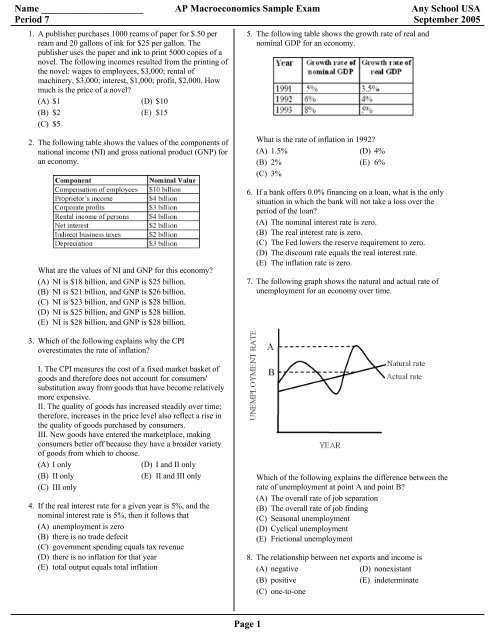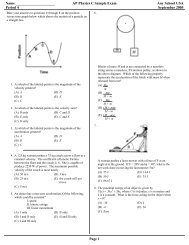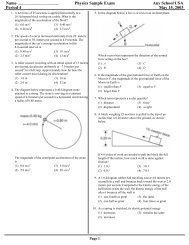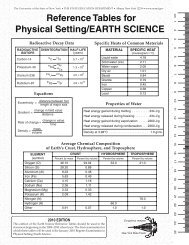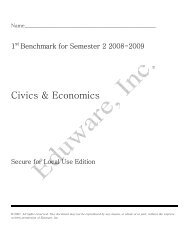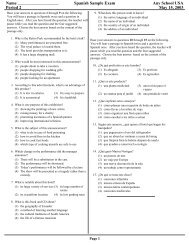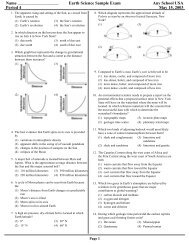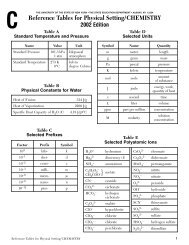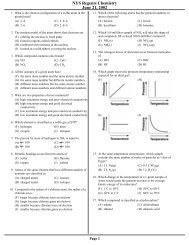The Wizard Test Maker - Eduware
The Wizard Test Maker - Eduware
The Wizard Test Maker - Eduware
Create successful ePaper yourself
Turn your PDF publications into a flip-book with our unique Google optimized e-Paper software.
Name _____________________ AP Macroeconomics Sample Exam Any School USA<br />
Period 7 September 2005<br />
1. A publisher purchases 1000 reams of paper for $.50 per<br />
ream and 20 gallons of ink for $25 per gallon. <strong>The</strong><br />
publisher uses the paper and ink to print 5000 copies of a<br />
novel. <strong>The</strong> following incomes resulted from the printing of<br />
the novel: wages to employees, $3,000; rental of<br />
machinery, $3,000; interest, $1,000; profit, $2,000. How<br />
much is the price of a novel<br />
(A) $1 (D) $10<br />
(B) $2 (E) $15<br />
(C) $5<br />
5. <strong>The</strong> following table shows the growth rate of real and<br />
nominal GDP for an economy.<br />
2. <strong>The</strong> following table shows the values of the components of<br />
national income (NI) and gross national product (GNP) for<br />
an economy.<br />
What are the values of NI and GNP for this economy<br />
(A) NI is $18 billion, and GNP is $25 billion.<br />
(B) NI is $21 billion, and GNP is $26 billion.<br />
(C) NI is $23 billion, and GNP is $28 billion.<br />
(D) NI is $25 billion, and GNP is $28 billion.<br />
(E) NI is $28 billion, and GNP is $28 billion.<br />
What is the rate of inflation in 1992<br />
(A) 1.5% (D) 4%<br />
(B) 2% (E) 6%<br />
(C) 3%<br />
6. If a bank offers 0.0% financing on a loan, what is the only<br />
situation in which the bank will not take a loss over the<br />
period of the loan<br />
(A) <strong>The</strong> nominal interest rate is zero.<br />
(B) <strong>The</strong> real interest rate is zero.<br />
(C) <strong>The</strong> Fed lowers the reserve requirement to zero.<br />
(D) <strong>The</strong> discount rate equals the real interest rate.<br />
(E) <strong>The</strong> inflation rate is zero.<br />
7. <strong>The</strong> following graph shows the natural and actual rate of<br />
unemployment for an economy over time.<br />
3. Which of the following explains why the CPI<br />
overestimates the rate of inflation<br />
I. <strong>The</strong> CPI measures the cost of a fixed market basket of<br />
goods and therefore does not account for consumers'<br />
substitution away from goods that have become relatively<br />
more expensive.<br />
II. <strong>The</strong> quality of goods has increased steadily over time;<br />
therefore, increases in the price level also reflect a rise in<br />
the quality of goods purchased by consumers.<br />
III. New goods have entered the marketplace, making<br />
consumers better off because they have a broader variety<br />
of goods from which to choose.<br />
(A) I only<br />
(D) I and II only<br />
(B) II only<br />
(E) II and III only<br />
(C) III only<br />
4. If the real interest rate for a given year is 5%, and the<br />
nominal interest rate is 5%, then it follows that<br />
(A) unemployment is zero<br />
(B) there is no trade defecit<br />
(C) government spending equals tax revenue<br />
(D) there is no inflation for that year<br />
(E) total output equals total inflation<br />
Which of the following explains the difference between the<br />
rate of unemployment at point A and point B<br />
(A) <strong>The</strong> overall rate of job separation<br />
(B) <strong>The</strong> overall rate of job finding<br />
(C) Seasonal unemployment<br />
(D) Cyclical unemployment<br />
(E) Frictional unemployment<br />
8. <strong>The</strong> relationship between net exports and income is<br />
(A) negative<br />
(D) nonexistant<br />
(B) positive<br />
(E) indeterminate<br />
(C) one-to-one<br />
Page 1
9.<br />
AP Macroeconomics Sample Exam<br />
<strong>The</strong> point of view expressed in this cartoon is that the 1997 increase in the minimum wage would<br />
(A) significantly reduce the gap between the rich and the poor (C) help workers climp the ladder of success<br />
(B) encourage the poor to appreciate the concern of politicians (D) be unlikely to provide any major benefit to the poor<br />
(E) save the United States economy forever<br />
10.<br />
An accurate description of the nation's business cycle<br />
between 1960 and 1980 is that it<br />
(A) experienced numerous periods of prosperity and<br />
depression<br />
(B) was most similar to the business cycle between 1930<br />
and 1940<br />
(C) remained generally prosperous<br />
(D) stayed at the average business level<br />
(E) destroyed the United States economy forever<br />
11. Who first introduced the consumption function<br />
(A) Adam Smith<br />
(D) Thomas Malthus<br />
(B) John Maynard Keynes (E) Vilfredo Pareto<br />
(C) David Ricardo<br />
12. According to Okun's Law, the growth rate of real GDP is<br />
given by 2.7% - 2dU, where dU is the change in the<br />
unemployment rate (expressed in percent per year). If the<br />
unemployment rate steadily increases from 5% to 7% from<br />
January to June, then<br />
(A) the economy shifts to a new point along its production<br />
possibilities frontier<br />
(B) the economy is rapidly recovering from a recession<br />
(C) the economy is displaying sustained economic growth<br />
(D) real and potential GDP are growing<br />
(E) the economy is in a recession<br />
13. In a closed economy without government intervention,<br />
planned aggregate expenditure (AE) is<br />
(A) Consumption + Savings<br />
(B) Consumption + Investment<br />
(C) Savings + Investment<br />
(D) Aggregate output + Investment<br />
(E) Aggregate output – Investment<br />
14. All of the following are investment EXCEPT<br />
(A) a restaurant owner buying tables<br />
(B) a department store adding to its inventories<br />
(C) purchasing a share of IBM<br />
(D) an automobile manufacturing purchasing a new plant<br />
(E) a software company purchasing a new computer<br />
Page 2
Base your answers to questions 15 through 19 on the following<br />
consumption and saving schedule (in billions of dollars)<br />
AP Macroeconomics Sample Exam<br />
Base your answers to questions 21 through 24 on the following<br />
consumption schedule. This is a closed economy with 0 taxes.<br />
<strong>The</strong> MPC is .75.<br />
15. Which is the correct consumption function for the<br />
displayed schedule<br />
(A) C = 100 + .25Y (D) C = 1000 + .75Y<br />
(B) C = 100 + 75.Y (E) C = .25Y<br />
(C) C = 1000 + .25Y<br />
16. What is the marginal propensity to save (MPS)<br />
(A) .8 (D) .75<br />
(B) .2 (E) .25<br />
(C) .5<br />
17. What is the value of L<br />
(A) 700 (D) 600<br />
(B) 800 (E) 500<br />
(C) 100<br />
18. What is the value of K<br />
(A) 0 (D) 400<br />
(B) 100 (E) 500<br />
(C) 300<br />
19. When Aggregate Income (Y) is at K, the savings function<br />
intersects the<br />
(A) consumption function (D) y-axis<br />
(B) 45º line<br />
(E) investment function<br />
(C) x-axis<br />
20. Which of the following is considered inventory for an<br />
automobile manufacturer<br />
21. What is the MPS<br />
(A) .1 (D) .75<br />
(B) .25 (E) .9<br />
(C) .5<br />
22. What is the consumption function<br />
(A) C = .75Y (D) C = 50 + .75Y<br />
(B) C = 50 + .25Y (E) C = –50 + .25Y<br />
(C) C = –50 + .75Y<br />
23. What is the saving function<br />
(A) S = 50 + .75Y (D) S = .75Y<br />
(B) S = 50 + .25Y (E) S = –50 + .75Y<br />
(C) S = –50 + .25Y<br />
24. What is saving when Y=1500<br />
(A) 275 (D) 425<br />
(B) 325 (E) 1175<br />
(C) 375<br />
25. How would rapidly falling stock prices affect the amount<br />
that firms invest in new capital<br />
(A) Investment in new capital would increase, because the<br />
price of new capital falls relative to stock prices<br />
(B) Investment in new capital would increase, because<br />
firms expect higher profits.<br />
(C) Investment in new capital would decrease, because the<br />
price of new capital rises relative to stock prices.<br />
(D) Investment in new capital would decrease, because the<br />
marginal productivity of capital has increased.<br />
(E) Investment in new capital would remain unchanged,<br />
because firms' expected future profits are unaffected<br />
by stock prices.<br />
I. Tires<br />
II. Steel<br />
III. Engine blocks<br />
IV. Cars<br />
(A) I only<br />
(B) IV only<br />
(C) I, III and IV<br />
(D) I, II, and III<br />
(E) I, II, III and IV<br />
26. Official government debt statistics include which of the<br />
following government liabilities<br />
I. Privately held government debt<br />
II. Pensions for government employees<br />
III. Promised Social Security payments<br />
(A) I only<br />
(D) II and III<br />
(B) II only<br />
(E) I, II and III<br />
(C) I and II<br />
Page 3
27. Suppose that firms expect a reduction in corporate income<br />
tax rates starting in 2005. How would this affect stock<br />
prices and firms' investment in new capital in 2004<br />
(A) Both stock prices and investment in new capital would<br />
be unaffected.<br />
(B) Both stock prices and investment in new capital would<br />
decrease.<br />
(C) Both stock prices and investment in new capital would<br />
increase.<br />
(D) Stock prices would increase, but investment in new<br />
capital would be unchanged.<br />
(E) Stock prices would be unchanged, but investment in<br />
new capital would increase.<br />
28. Increased desire to save shifts S to S'<br />
AP Macroeconomics Sample Exam<br />
31. Which of the following are injections into the circular<br />
flow<br />
I. Exports<br />
II. Taxes<br />
III. Saving<br />
IV. Government spending<br />
V. Investment<br />
(A) I only<br />
(D) I, IV and V<br />
(B) II and III<br />
(E) I, II, III and V<br />
(C) II, III and V<br />
32. <strong>The</strong> two principal types of trade restrictions used by<br />
nations are<br />
(A) tariffs and quotas<br />
(B) research and development<br />
(C) corporate income taxes and personal income taxes<br />
(D) immigration limits and travel restrictions<br />
(E) police patrols and currency limitations<br />
33. If income rises from $100 to $1100 and imports go from<br />
$200 to $220, what is the marginal propensity to import<br />
(MPM)<br />
(A) .1 (D) .8<br />
(B) .2 (E) 1<br />
(C) .5<br />
Base your answers to questions 34 through 36 on the table below.<br />
Also assume that I=100, G=100, and T=100.<br />
<strong>The</strong> displayed graph illustrates<br />
(A) the sticky price model<br />
(B) the paradox of thrift<br />
(C) the real wealth effect<br />
(D) crowding out<br />
(E) crowding in<br />
29. Which of the following is an example of an automatic<br />
stabilizer<br />
(A) An increase in defense spending during an expansion<br />
(B) A decrease in social security benefits during a<br />
recession<br />
(C) An increase in welfare benefits during an expansion<br />
(D) A decrease in unemployment benefits paid out during<br />
an expansion<br />
(E) An increase in taxes during a recession<br />
30. Which of the following arguments for trade protection is<br />
frequently cited by developing countries<br />
(A) <strong>The</strong> military-self-sufficiency argument<br />
(B) <strong>The</strong> infant-industry argument<br />
(C) <strong>The</strong> cheap-foreign-labor argument<br />
(D) <strong>The</strong> deadweight-loss argument<br />
(E) <strong>The</strong> autonomy arguement<br />
34. Which most closely represents the government purchases<br />
multiplier in this economy<br />
(A) 1.43 (D) 2.5<br />
(B) 1.67 (E) 3.33<br />
(C) 2<br />
35. What is the tax multiplier in this economy<br />
(A) -1.67 (D) 1.5<br />
(B) -1.5 (E) 1.67<br />
(C) 1<br />
36. What is the balanced budget multiplier for this economy<br />
(A) -2.5 (D) 1.67<br />
(B) -1.5 (E) 2.5<br />
(C) 1<br />
Page 4
37. Most economists believe that the long-run aggregate<br />
supply curve is vertical because<br />
(A) actual output can never exceed, even temporarily, the<br />
natural rate of output<br />
(B) a vertical long-run supply curve indicates the<br />
maximum level of output that an economy can ever<br />
achieve<br />
(C) a vertical long-run supply curve indicates that an<br />
increase in aggregate demand will lead to a larger real<br />
output but not a larger nominal output<br />
(D) in the long run, the level of output produced in the<br />
economy is determined by work ethic<br />
(E) in the long run, the level of output produced in the<br />
economy is determined by resources and technology<br />
38. What is the meaning of "sticky wages"<br />
(A) <strong>The</strong> fact that wages tend to rise with an increase in<br />
labor demand.<br />
(B) <strong>The</strong> fact that at w 0<br />
, the quantity of labor demanded is<br />
greater than the quantity of labor supplied.<br />
(C) <strong>The</strong> fact that the shift in labor demand does not move<br />
the market toward the equilibrium, causing an increase<br />
in unemployment.<br />
(D) <strong>The</strong> fact that wages fall if the demand for labor falls.<br />
(E) <strong>The</strong> fact that unemployment remains even.<br />
39. A nation's central bank increases the monetary base,<br />
thereby lowering interest rates. If the currency-deposit ratio<br />
and the reserve-deposit ratio are sensitive only to changes<br />
in interest rates, then how would expansionary monetary<br />
policy affect the money multiplier and the money supply<br />
(A) <strong>The</strong> money multiplier and the money supply would<br />
increase.<br />
(B) <strong>The</strong> money multiplier and the money supply would<br />
decrease.<br />
(C) <strong>The</strong> money multiplier would increase, and the money<br />
supply would decrease.<br />
(D) <strong>The</strong> money multiplier would decrease, and the money<br />
supply would increase.<br />
(E) <strong>The</strong> money multiplier would increase, but the effect on<br />
the money supply is uncertain.<br />
40. Suppose that the monetary base initially equals $200<br />
billion, and the money supply initially equals $800 billion.<br />
A change in the monetary base causes the money supply to<br />
increase to $1,200 billion. Assuming that the money<br />
multiplier remains constant, the monetary base would now<br />
equal<br />
(A) $100 billion<br />
(D) $800 billion<br />
(B) $200 billion<br />
(E) $1,200 billion<br />
(C) $300 billion<br />
41. By lowering the discount rate, the Federal Reserve can<br />
(A) increase the money supply<br />
(B) decrease the money supply<br />
(C) raise interest rates<br />
(D) lower reserve requirements<br />
(E) cause a recession<br />
AP Macroeconomics Sample Exam<br />
42. Mr. Economicus discovered that his grandfather (who<br />
feared a banking crisis similar to that of the early 1930's)<br />
had stashed $100,000 under his matress. Mr. Economicus<br />
convinced his grandfather to deposit the $100,000 in an<br />
FDIC-insured checking account. Suppose that the Fed<br />
bought $100,000 in government securities on the<br />
open-market. Does a deposit of $100,000 or an<br />
open-market purchase of $100,000 result in a greater<br />
increase in the money supply<br />
(A) Both result in an equal increase in the money supply.<br />
(B) <strong>The</strong> deposit of $100,000 results in a greater increase in<br />
the money supply.<br />
(C) <strong>The</strong> open-market purchase of $100,000 results in a<br />
greater increase in the money supply.<br />
(D) <strong>The</strong> deposit of $100,000 results in a greater increase in<br />
the money supply, if and only if the reserve-deposit<br />
ratio is less than 50%.<br />
(E) <strong>The</strong> deposit of $100,000 results in a greater increase in<br />
the money supply, if and only if the reserve<br />
requirement is less than 50%.<br />
43. If the Federal Reseve Bank sells large amounts of<br />
government securities on the open market, then<br />
I. the monetary base will increase.<br />
II. the money supply will contract.<br />
III. the federal funds rate will rise.<br />
IV. the supply of credit will increase.<br />
(A) I and III only<br />
(D) II, III, and IV only<br />
(B) II and III only<br />
(E) I, III, and IV only<br />
(C) III and IV only<br />
44. During the winter holiday season, individuals typically<br />
make large withdrawals of cash from banks. How would<br />
this seasonal increase in currency affect bank reserves, and<br />
what actions would the Fed pursue to counteract the<br />
resulting change in reserves<br />
(A) Bank reserves would increase, and the Fed would sell<br />
government securities on the open market.<br />
(B) Bank reserves would increase, and the Fed would buy<br />
government securities on the open market.<br />
(C) Bank reserves would decrease, and the Fed would buy<br />
government securities on the open market.<br />
(D) Bank reserves would decrease, and the Fed would sell<br />
government securities on the open market.<br />
(E) Bank reserves would decrease, and the Fed would<br />
substantially lower the reserve requirement.<br />
45. If an economy is at full employment, how will an increase<br />
in the federal defecit affect unemployment<br />
(A) It will increase aggregate demand and raise<br />
unemployment.<br />
(B) It will decrease aggregate demand and raise<br />
unemployment.<br />
(C) It will increase aggregate demand and lower<br />
unemployment.<br />
(D) It will decrease aggregate demand and lower<br />
unemployment.<br />
(E) It will increase aggregate demand and have no effect<br />
on unemployment.<br />
Page 5
Base your answers to questions 46 and 47 on the charts below<br />
and on your knowledge of economics.<br />
AP Macroeconomics Sample Exam<br />
50. <strong>The</strong> following graph shows a nation's government debt<br />
over time. Assume that both the inflation rate and the level<br />
of government expenditures remain constant.<br />
46. Which statement is most clearly supported by the<br />
information in the charts<br />
(A) Most farms in the United States are owned by<br />
corporations.<br />
(B) <strong>The</strong> United States government is not doing enough to<br />
help farmers.<br />
(C) <strong>The</strong> nation will need more farmers in the near future.<br />
(D) <strong>The</strong> number of farmers declined while farm output<br />
increased.<br />
(E) <strong>The</strong> United States government owns too many farms.<br />
47. <strong>The</strong> trends shown in the charts were most likely caused by<br />
(A) failure to use the latest farm technology<br />
(B) increases in productivity<br />
(C) changes in consumer tastes<br />
(D) competition from imported food products<br />
(E) a decline in the value of American currency<br />
51.<br />
Which of the following might explain the difference in<br />
government debt between points C and A<br />
(A) Consecutive budget surpluses<br />
(B) A rise in personal income tax rates<br />
(C) An increase in tax revenues<br />
(D) An inflation rate greater than zero<br />
(E) An inflation rate less than zero<br />
48. Expansionary monetary policy will have what effect on<br />
unemployment in the short-run and long-run respectively<br />
(A) Increase in the short-run, decrease in the long-run.<br />
(B) Unaffected in the short-run, decrease in the long-run.<br />
(C) Increase in the short-run, increase in the long-run.<br />
(D) Increase in the short-run, unaffected in the long-run.<br />
(E) Decrease in the short-run, unaffected in the long-run.<br />
49. If the short-run Phillips curve shifts inward, which of the<br />
following might have occurred<br />
(A) <strong>The</strong> Federal Reserve cut taxes.<br />
(B) Government spending increased.<br />
(C) Inflationary expectations decreased.<br />
(D) Unemployment is rising.<br />
(E) <strong>The</strong> exchange rate is decreasing.<br />
Based on the above diagram, which of the following could<br />
cause a shift from point A to point B<br />
(A) Increase is demand for Francs<br />
(B) Decreased political stability in France<br />
(C) Expectations that the Franc will appreciate<br />
(D) A relative increase in interest rates in France<br />
(E) Increase in relative level of income in France<br />
52. Suppose the government increases taxes in order to<br />
alleviate a budget defecit. In an open economy, what<br />
effect will this have<br />
(A) It will increase the trade defecit.<br />
(B) It will increase the real interest rate.<br />
(C) It will decrease net foreign investment.<br />
(D) It will decrease net exports.<br />
(E) It will increase prices.<br />
Page 6
53. Which of the following measures would increase the<br />
federal budget deficit<br />
I. Lowering taxes<br />
II. Increasing federal spending<br />
III. Raising interest rates<br />
(A) I only<br />
(D) I and III only<br />
(B) II only<br />
(E) I, II, and III<br />
(C) III only<br />
54. Assume that the required reserve requirement is 30%.<br />
AP Macroeconomics Sample Exam<br />
59. <strong>The</strong> volume of seasonal borrowing at the discount window<br />
(A) is highest in heavily industrialized Federal Reseve<br />
districts<br />
(B) has steadily increased during the 1990's as many<br />
regions have shifted toward a more agrarian economy<br />
(C) is greatest during spring and summer months because<br />
agricultural banks must fulfill farmers' demand for<br />
loans to finance planting and growing<br />
(D) rises during the fall as farmers harvest their crops and<br />
pay back their bank loans<br />
(E) does not fluctuate throughout the year<br />
If a bank initially has no excess reserves and $30,000 cash<br />
is deposited in the bank, the bank can increase its loans by<br />
a maximum of<br />
(A) $2,000 (D) $42,000<br />
(B) $11,000 (E) $100,000<br />
(C) $21,000<br />
55. If a bank has reserves of $20,000, outstanding loans of<br />
$80,000 and deposits of $80,000, what may be missing<br />
from the balance sheet<br />
(A) borrowed reserves of $20,000 on the assets side<br />
(B) borrowed reserves of $20,000 on the liabilities side<br />
(C) excess reserves of $20,000 on the assets side<br />
(D) excess reserves of $20,000 on the liabilities side<br />
(E) the balance sheet is complete<br />
56. <strong>The</strong> Federal Reserve decides to lower the discount rate,<br />
and as a result banks borrow an additional $100 million. If<br />
the reserve requirement is 15%, the money supply will<br />
increase by approximately<br />
(A) $15 million<br />
(D) $117 million<br />
(B) $670 million<br />
(E) $85 million<br />
(C) $1.5 billion<br />
57. Suppose that the spread between the federal funds rate and<br />
the discount rate is positive. A large increase in the<br />
demand for reseves will cause<br />
I. a rise in the federal funds rate<br />
II. a wider spread between the federal funds rate and the<br />
discount rate<br />
III. an increase in the level of discount window borrowing<br />
(A) I only<br />
(D) II and III only<br />
(B) I and II only<br />
(E) I, II, and III<br />
(C) I and III only<br />
58. Supply side economists believe that<br />
(A) a cut in high tax rates results in an increased deficit<br />
and thus increases aggregate supply<br />
(B) the aggregate supply of goods can only increase if the<br />
price level falls<br />
(C) increased government spending should be used to<br />
stimulate the economy<br />
(D) lower tax rates provide work incentives and shift the<br />
aggregate supply curve to the right<br />
(E) the government should regulate foreign trade<br />
60. If the government increases the federal defecit, what will<br />
the effect be on unemployment in both the short-run and<br />
the long-run<br />
(A) It will rise in the short-run and fall in the short-run.<br />
(B) It will fall in the short-run and rise in the short-run.<br />
(C) It will fall in the short-run and be unaffected in the<br />
long-run.<br />
(D) It will fall in the short-run and the long-run.<br />
(E) It will rise in the short-run and the long-run.<br />
61. Suppose that statisticians observe the following values for<br />
the growth rate of the CPI and the unemployment rate<br />
between 2005 and 2009.<br />
Which of the following might explain the changes in the<br />
inflation rate and the unemployment rate between 2005 and<br />
2007<br />
(A) an adverse supply shock<br />
(B) a decline in inflationary expectations<br />
(C) a fall in real interest rates<br />
(D) an increase in government expenditures<br />
(E) a decrease in real money balances<br />
62. <strong>The</strong> shifting of the aggregate demand curve to the right<br />
relative to the aggregate supply curve best represents<br />
(A) cost-push inflation (D) hyperinflation<br />
(B) stagflation<br />
(E) galloping inflation<br />
(C) demand-pull inflation<br />
63. An increase in price levels when aggregate supply remains<br />
the same could be caused by<br />
(A) increased government spending<br />
(B) increased taxes<br />
(C) increased imports<br />
(D) decreased investment<br />
(E) decreased oil prices<br />
Page 7
64.<br />
AP Macroeconomics Sample Exam<br />
67. Base your answer to the following question on the<br />
following economy.<br />
C = 100 + .5Y d<br />
G = 500<br />
I (planned) = 150<br />
T = 500<br />
If Y = 1000 and Taxes = T+.1Y, what is disposable<br />
income<br />
(A) 400 (D) 1000<br />
(B) 450 (E) 1100<br />
(C) 500<br />
<strong>The</strong> shift in the above diagram represents which of the<br />
following<br />
(A) Increased inflationary expectations.<br />
(B) Decreased inflationary expectations.<br />
(C) Increased inflation.<br />
(D) Increased unemployment.<br />
(E) Increased output.<br />
65. Which of the following is true<br />
(A) <strong>The</strong> slowest growing countries in the world, many of<br />
which are experiencing declines in per capita GDP,<br />
are high income industrial countries.<br />
(B) <strong>The</strong> fastest-growing economies in the world are<br />
mostly less developed countries.<br />
(C) <strong>The</strong> fastest-growing economies in the world (those<br />
with annual real growth rates of 3.5 percent or more)<br />
are mostly high-income industrial countries.<br />
(D) <strong>The</strong> fastest-growing economies in the world have<br />
well-educated populace.<br />
(E) <strong>The</strong> fastest-growing economies in the world are<br />
low-debt nations.<br />
66.<br />
68. <strong>The</strong> aggregate demand curve represents the relationship<br />
between<br />
(A) GDP and price level<br />
(B) GDP and interest rates<br />
(C) price level and employment<br />
(D) GDP and unemployment<br />
(E) price level and inflation<br />
69. Imports depend on domestic income because<br />
(A) of their rleationship to exports<br />
(B) they are part of consumption<br />
(C) they do not affect aggregate expenditure<br />
(D) they are not part of consumption<br />
(E) they are part of aggregate expenditure<br />
70. If an economy is initially operating at its natural rate of<br />
output, which of the following would most likely increase<br />
the rate of inflation<br />
(A) an increase in personal income taxes<br />
(B) a decline in the money supply<br />
(C) a sizable increase in government expenditures<br />
(D) a decline in energy prices<br />
(E) a fall in nominal wage rates<br />
71. Why does equilibrium income rise by more than $100 in<br />
response to a $100 increase in government spending<br />
(A) Incomes will rise, resulting in a decrease in taxes<br />
(B) <strong>The</strong> higher budget deficit reduces investment<br />
(C) <strong>The</strong> increased spending raises the aggregate price<br />
level<br />
(D) <strong>The</strong> increased spending increases the money supply,<br />
lowering interest rates<br />
(E) Incomes will rise, resulting in more consumption<br />
72. Which of the following are functions of money<br />
If the United States is the home country in an open<br />
economy, the shift in the above diagram could be a result<br />
of<br />
(A) An increase in foreign investment into the US.<br />
(B) An increase in demand for the dollar.<br />
(C) An increase in government spending in the US.<br />
(D) An increase in taxes in the US.<br />
(E) A decreasee in the reserve requirement for US banks.<br />
I. a store of value<br />
II. a unit of account<br />
III. a medium of exchange<br />
(A) II only<br />
(B) III only<br />
(C) I and II only<br />
(D) II and III only<br />
(E) I, II, and III<br />
Page 8
73. <strong>The</strong> following questions examine an international economy.<br />
(a) Why has there not been more global coordination on monetary and fiscal policies, given the interdependence among countries<br />
(b) Why did the rising dollar of the early 1980’s lead to a massive trade deficit in the United States<br />
(c) How do exchange rate changes affect aggregate demand<br />
74. In an open economy, the government imposed import tariff on foreign goods.<br />
75.<br />
AP Macroeconomics Sample Exam<br />
(a) Explain how this policy will affect both net exports and the trade deficit for this country.<br />
(b) Explain the effect of this quota on the following.<br />
(i) Prices that consumers in the home country pay.<br />
(ii) Prices that producers in the home country receive.<br />
(iii) Prices that producers abroad receive.<br />
(iv) Government tax revenue.<br />
(c) Suppose the government wants to get the same effect as (iv) without restricting trade. Give one example of a policy that would<br />
accomplish this result.<br />
<strong>The</strong> short-run Phillips curve for Macroland is shown below. Macroland is currently operating at point A, where the inflation rate is 2%<br />
and unemployment is at its natural rate of 6%.<br />
(a) Describe two events that may shift the short-run Phillips curve upward through point C.<br />
(b) Suppose that policymakers decide that the economy should be operating at point B in the short run. If the desired inflation rate is 5%,<br />
what should be the target growth rate for the money supply Assume that the growth rate of real GDP is fixed at 2% and that the<br />
quantity theory of money is accurate.<br />
(c) List two actions that Macroland’s central bank could take to expand the money supply.<br />
(d) <strong>The</strong> central bank determines that the money supply must increase by $200 billion in order to attain the target inflation rate. If the<br />
reserve requirement is 10%, what is the minimum amount of reserves that the central bank must inject into the banking system, in order<br />
to achieve the desired increase in the money supply<br />
(e) Explain why Macroland cannot be permanently operating at point B.<br />
76. What is the difference between economic development and economic growth Give examples of how each of these concepts, and how<br />
they can be measured. What are the determinants of economic growth<br />
77. Use aggregate supply and demand diagrams to explain what would happen to GDP and the price level in the following circumstances:<br />
(a) Consumers decide to cut back on savings and buy more domestic appliances.<br />
(b) Tornadoes destroy many factories, while a drought ruins many crops.<br />
(c) Miraculous new technological developments raise productivity.<br />
(d) Because of worries over the deficit, the government cuts back on expenditures on social programs.<br />
Page 9
Name _____________________ AP Macroeconomics Sample Exam Any School USA<br />
Period 7 September 2005<br />
Answer Key<br />
1. B<br />
2. C<br />
3. A<br />
4. D<br />
5. B<br />
6. E<br />
7. D<br />
8. B<br />
9. D<br />
10. C<br />
11. B<br />
12. E<br />
13. B<br />
14. C<br />
15. B<br />
16. E<br />
17. A<br />
18. A<br />
19. C<br />
20. E<br />
21. B<br />
22. D<br />
23. C<br />
24. B<br />
25. C<br />
26. A<br />
27. C<br />
28. B<br />
29. D<br />
30. B<br />
31. D<br />
32. A<br />
33. B<br />
34. D<br />
35. B<br />
36. C<br />
37. E<br />
38. C<br />
39. D<br />
40. D<br />
41. A<br />
42. C<br />
43. B<br />
44. C<br />
45. C<br />
46. D<br />
47. B<br />
48. E<br />
49. C<br />
50. D<br />
51. C<br />
52. D<br />
53. E<br />
54. C<br />
55. B<br />
56. B<br />
57. E<br />
58. D<br />
59. C<br />
60. C
Name _____________________ AP Macroeconomics Sample Exam Any School USA<br />
Period 7 September 2005<br />
61. A<br />
62. C<br />
63. A<br />
64. B<br />
65. B<br />
66. D<br />
67. A<br />
68. A<br />
69. B<br />
70. C<br />
71. E<br />
72. E<br />
Answer Key<br />
73. (a) While it is true that in an open economy the effects of monetary<br />
and fiscal policies must consider secondary effects in the foreign<br />
exchange market, countries hesitate to surrender autonomy in their<br />
own economies.<br />
(b) A rising dollar makes our goods more expensive to foreigners,<br />
leading to lower U.S. exports. AT the same time, we import more<br />
given our increased purchasing power. Both changes contribute to a<br />
rising trade deficit.<br />
(c) A currency appreciation will decrease aggregate demand. If<br />
currency appreciates, exports become more expensive. Net exports<br />
therefore fall, which lessens aggregate demand.<br />
74. (a) Net exports = Exports – Imports, therefore net exports would<br />
increase. Trade deficit = Imports – exports, therefore the trade<br />
deficit would decrease.<br />
(b) i. Increase.<br />
ii. Remains the same.<br />
iii. Decrease.<br />
iv. Increase.<br />
(c) Any contractionary fiscal policy would increase government<br />
revenue, and would not affect the net exports of the home country.<br />
75. (a) An upward shift in the short-run Phillips curve indicates an<br />
increase in the inflation rate at each level of unemployment. <strong>The</strong> three<br />
factors that determine the y-intercept of the Phillips curve are: the<br />
expected rate of inflation; the natural rate of unemployment; and<br />
supply shocks. An adverse supply shock, a rise in the expected rate of<br />
inflation, or an increase in the natural rate of unemployment would<br />
raise the y-intercept, thereby shifting the Phillips curve upward.<br />
Adverse supply shocks include: an increase in energy prices; a natural<br />
disaster; or a rise in corporate income tax rates. A widespread belief<br />
that the central bank is committed to a policy of monetary expansion<br />
would raise the expected rate of inflation. <strong>The</strong> natural rate of<br />
unemployment may be increased by: a rise in personal income tax<br />
rates; a rise in the minimum wage; a decrease in the efficiency of the<br />
job-finding process; or a decrease in the skill level of the workforce.<br />
(b) <strong>The</strong> equation of exchange is given by MV = PY. Taking the<br />
growth rates of both sides, we obtain dM + dV = dP + dY, where dX<br />
is the growth rate of the variable X. Since the quantity theory of<br />
money assumes that the velocity of money is constant, dV is equal to<br />
zero. If the growth rate of real GDP is 2% and the inflation rate is<br />
5%, then the growth rate of the money supply should be (5% + 2%)<br />
or 7%.<br />
(c) <strong>The</strong> three principle instruments of monetary policy are: the<br />
purchase and sale of government securities; reserve requirements;<br />
and the discount rate (known the bank rate outside the U.S.). If the<br />
central bank desired to expand the money supply, it could purchase<br />
government securities, lower the reserve requirement, or lower the<br />
discount rate.<br />
d) <strong>The</strong> maximum rise in the money supply that would result from an<br />
injection of reserves into the banking system is (d/r), where d is the<br />
amount of reserves added and r is the reserve requirement. We are<br />
looking for the minimum injection d that would increase the money<br />
supply by $200 billion with r = .10. <strong>The</strong> minimum injection of<br />
reserves is ($200 billion)(.10) or $20 billion.<br />
(e) If the central bank systematically raised the inflation rate from<br />
2% to 5%, the Phillips curve would shift upward because individuals<br />
would now expect an inflation rate of 5%. Thus, in the long-run the<br />
economy would be operating at the natural rate of unemployment<br />
(6%) but with an inflation rate of 5% instead of 2%. <strong>The</strong> short-run<br />
tradeoff between inflation and unemployment does not exist in the<br />
long run.<br />
76. Economic growth is defined as an increase in per capita GDP. <strong>The</strong><br />
most important determinants of economic growth include labor,<br />
capital, the marginal product of labor, the marginal of capital, and<br />
technology. In the 21st century human capital, education, and the<br />
ability to use information will probably be important determinants<br />
of economic growth.<br />
Economic development, on the other hand, is qualitative.<br />
Improvement in such indicators as malnutrition, literacy, life<br />
expectancy, and infant mortality are viewed as signs of economic<br />
development.<br />
77. (a) This is the positive demand shock, which shifts the demand<br />
curve to the right. GDP is higher and the price level is higher in a<br />
new equilibrium.<br />
(b) This is the negative supply shock, which shifts the supply curve<br />
to the left. GDP is lower and the price level is higher in a new<br />
equilibrium.<br />
(c) This is the positive supply shock, which shifts the supply curve<br />
to the right. GDP is higher and the price level is lower in a new<br />
equilibrium.<br />
(d) This is the negative demand shock, which shifts the demand<br />
curve to the left. GDP is lower and the price level is lower in a new<br />
equilibrium.
<strong>Eduware</strong> Genealogy by Question<br />
Displaying UNIT CHAPTER TOPIC SUBTOPIC QUESTION ID<br />
1. III. Macroeconomics / 1. Measurement of Economic Performance / A. National Income Accounts / 2. Gross Domestic Product : 0000148<br />
2. III. Macroeconomics / 1. Measurement of Economic Performance / A. National Income Accounts / 2. Gross Domestic Product : 0000181<br />
3. III. Macroeconomics / 1. Measurement of Economic Performance / C. Inflation / 1. Price Indices : 0000170<br />
4. III. Macroeconomics / 1. Measurement of Economic Performance / C. Inflation / 2. Nominal and real interest rates : 0001061<br />
5. III. Macroeconomics / 1. Measurement of Economic Performance / C. Inflation / 1. Price Indices : 0000183<br />
6. III. Macroeconomics / 1. Measurement of Economic Performance / C. Inflation / 2. Nominal and real interest rates : 0001062<br />
7. III. Macroeconomics / 1. Measurement of Economic Performance / D. Unemployment / 4. Natural rate of unemployment : 0000198<br />
8. III. Macroeconomics / 2. National Income and Price Determination / A. Aggregate Demand / 5. Net Exports : 0000475<br />
9. III. Macroeconomics / 1. Measurement of Economic Performance / D. Unemployment / 1. Definition : 0000838<br />
10. III. Macroeconomics / 1. Measurement of Economic Performance / E. Business Cycle / 1. Peak : 0000863<br />
11. III. Macroeconomics / 2. National Income and Price Determination / A. Aggregate Demand / 2. Consumption : 0000381<br />
12. III. Macroeconomics / 1. Measurement of Economic Performance / E. Business Cycle / 2. Recession : 0000197<br />
13. III. Macroeconomics / 2. National Income and Price Determination / A. Aggregate Demand / 3. Government : 0000380<br />
14. III. Macroeconomics / 2. National Income and Price Determination / A. Aggregate Demand / 3. Government : 0000371<br />
15. III. Macroeconomics / 2. National Income and Price Determination / A. Aggregate Demand / 2. Consumption : 0000372<br />
16. III. Macroeconomics / 2. National Income and Price Determination / A. Aggregate Demand / 2. Consumption : 0000373<br />
17. III. Macroeconomics / 2. National Income and Price Determination / A. Aggregate Demand / 2. Consumption : 0000374<br />
18. III. Macroeconomics / 2. National Income and Price Determination / A. Aggregate Demand / 2. Consumption : 0000375<br />
19. III. Macroeconomics / 2. National Income and Price Determination / A. Aggregate Demand / 2. Consumption : 0000376<br />
20. III. Macroeconomics / 2. National Income and Price Determination / A. Aggregate Demand / 3. Government : 0000377<br />
21. III. Macroeconomics / 2. National Income and Price Determination / A. Aggregate Demand / 2. Consumption : 0000442<br />
22. III. Macroeconomics / 2. National Income and Price Determination / A. Aggregate Demand / 2. Consumption : 0000443<br />
23. III. Macroeconomics / 2. National Income and Price Determination / A. Aggregate Demand / 2. Consumption : 0000444<br />
24. III. Macroeconomics / 2. National Income and Price Determination / A. Aggregate Demand / 2. Consumption : 0000445<br />
25. III. Macroeconomics / 2. National Income and Price Determination / A. Aggregate Demand / 3. Government : 0000264<br />
26. III. Macroeconomics / 2. National Income and Price Determination / A. Aggregate Demand / 4. Investment : 0000593<br />
27. III. Macroeconomics / 2. National Income and Price Determination / A. Aggregate Demand / 3. Government : 0000265<br />
28. III. Macroeconomics / 2. National Income and Price Determination / A. Aggregate Demand / 3. Government : 0000458<br />
29. III. Macroeconomics / 2. National Income and Price Determination / A. Aggregate Demand / 4. Investment : 0000634<br />
30. III. Macroeconomics / 2. National Income and Price Determination / A. Aggregate Demand / 5. Net Exports : 0000555<br />
31. III. Macroeconomics / 2. National Income and Price Determination / A. Aggregate Demand / 5. Net Exports : 0000540<br />
32. III. Macroeconomics / 2. National Income and Price Determination / A. Aggregate Demand / 5. Net Exports : 0000575<br />
33. III. Macroeconomics / 2. National Income and Price Determination / A. Aggregate Demand / 5. Net Exports : 0000578<br />
34. III. Macroeconomics / 2. National Income and Price Determination / B. Multipliers / 1. Government Spending Multiplier : 0000532<br />
35. III. Macroeconomics / 2. National Income and Price Determination / B. Multipliers / 2. Tax Multiplier : 0000533<br />
36. III. Macroeconomics / 2. National Income and Price Determination / B. Multipliers / 1. Government Spending Multiplier : 0000534<br />
37. III. Macroeconomics / 2. National Income and Price Determination / C. Aggregate Supply / 3. Long Run : 0000777<br />
38. III. Macroeconomics / 2. National Income and Price Determination / C. Aggregate Supply / 4. Sticky Price/Wage Model : 0000663<br />
39. III. Macroeconomics / 3. Financial Sector / B. Banks / 2. Creation of Money : 0000029<br />
40. III. Macroeconomics / 3. Financial Sector / B. Banks / 2. Creation of Money : 0000017<br />
41. III. Macroeconomics / 4. Macroeconomic Stabilization Policies / B. Monetary Policy / 1. Expansionary Monetary Policy : 0000982<br />
42. III. Macroeconomics / 3. Financial Sector / D. Tools of the Central Bank / 1. Open Market Operations : 0000071<br />
43. III. Macroeconomics / 3. Financial Sector / D. Tools of the Central Bank / 1. Open Market Operations : 0000077<br />
44. III. Macroeconomics / 3. Financial Sector / D. Tools of the Central Bank / 1. Open Market Operations : 0000086<br />
45. III. Macroeconomics / 4. Macroeconomic Stabilization Policies / A. Fiscal Policy / 3. Government Budget Surplus/Deficit : 0001108<br />
46. III. Macroeconomics / 6. Growth and Productivity / C. Technological Progress / 1. Technological Progress : 0000869<br />
47. III. Macroeconomics / 6. Growth and Productivity / C. Technological Progress / 1. Technological Progress : 0000870<br />
48. III. Macroeconomics / 4. Macroeconomic Stabilization Policies / B. Monetary Policy / 1. Expansionary Monetary Policy : 0001095<br />
49. III. Macroeconomics / 5. Macroeconomic Indicators/Policy Solutions / C. Effects of Expectations / 1. Effects of Expectations : 0001115<br />
50. III. Macroeconomics / 4. Macroeconomic Stabilization Policies / A. Fiscal Policy / 3. Government Budget Surplus/Deficit : 0000280<br />
51. III. Macroeconomics / 7. International Economics / B. Foreign Exchange Market / 1. Exchange Rate Determination : 0001052<br />
52. III. Macroeconomics / 7. International Economics / D. Links to Domestic Markets / 2. Output Effects : 0001032<br />
53. III. Macroeconomics / 4. Macroeconomic Stabilization Policies / A. Fiscal Policy / 3. Government Budget Surplus/Deficit : 0000826<br />
54. III. Macroeconomics / 3. Financial Sector / B. Banks / 2. Creation of Money : 0000326<br />
55. III. Macroeconomics / 3. Financial Sector / B. Banks / 3. Balance Sheet : 0001321<br />
56. III. Macroeconomics / 3. Financial Sector / D. Tools of the Central Bank / 2. Discount Rate : 0000916<br />
57. III. Macroeconomics / 3. Financial Sector / D. Tools of the Central Bank / 2. Discount Rate : 0000115
<strong>Eduware</strong> Genealogy by Question<br />
58. III. Macroeconomics / 4. Macroeconomic Stabilization Policies / A. Fiscal Policy / 5. Supply Side Economics : 0000828<br />
59. III. Macroeconomics / 3. Financial Sector / D. Tools of the Central Bank / 2. Discount Rate : 0000120<br />
60. III. Macroeconomics / 4. Macroeconomic Stabilization Policies / A. Fiscal Policy / 3. Government Budget Surplus/Deficit : 0001118<br />
61. III. Macroeconomics / 4. Macroeconomic Stabilization Policies / A. Fiscal Policy / 3. Government Budget Surplus/Deficit : 0000247<br />
62. III. Macroeconomics / 5. Macroeconomic Indicators/Policy Solutions / A. Inflation / 1. Demand-pull : 0001236<br />
63. III. Macroeconomics / 5. Macroeconomic Indicators/Policy Solutions / A. Inflation / 1. Demand-pull : 0001241<br />
64. III. Macroeconomics / 5. Macroeconomic Indicators/Policy Solutions / B. Phillips Curve / 1. Short Run : 0001123<br />
65. III. Macroeconomics / 6. Growth and Productivity / D. Public Policy and Long Run Growth / 1. Public Policy and Long Run Growth :<br />
0000757<br />
66. III. Macroeconomics / 7. International Economics / D. Links to Domestic Markets / 1. Monetary Effects : 0001002<br />
67. III. Macroeconomics / 2. National Income and Price Determination / A. Aggregate Demand / 4. Investment : 0000649<br />
68. III. Macroeconomics / 2. National Income and Price Determination / A. Aggregate Demand / 1. Definition : 0001297<br />
69. III. Macroeconomics / 2. National Income and Price Determination / A. Aggregate Demand / 5. Net Exports : 0000474<br />
70. III. Macroeconomics / 4. Macroeconomic Stabilization Policies / A. Fiscal Policy / 1. Expansionary Fiscal Policy : 0000255<br />
71. III. Macroeconomics / 2. National Income and Price Determination / B. Multipliers / 1. Government Spending Multiplier : 0000310<br />
72. III. Macroeconomics / 3. Financial Sector / A. Financial Assets / 1. Money : 0000030<br />
73. III. Macroeconomics / 9. Part II Questions / G. International Economics / 1. Foreign Exchange Market : 0001170<br />
74. III. Macroeconomics / 9. Part II Questions / G. International Economics / 2. Links to Domestic Markets : 0001149<br />
75. III. Macroeconomics / 9. Part II Questions / E. Macroeconomic Indicators/Policy Solutions / 2. Phillip's Curve : 0001173<br />
76. III. Macroeconomics / 9. Part II Questions / F. Growth and Productivity / 1. Public Policy and Long Run Growth : 0001159<br />
77. III. Macroeconomics / 9. Part II Questions / B. National Income and Price Determination / 2. Equilibrium : 0001160
<strong>Eduware</strong> Genealogy by Category<br />
2: III. Macroeconomics\1. Measurement of Economic Performance\A. National Income Accounts\2. Gross Domestic Product - (1, 2)<br />
2: III. Macroeconomics\1. Measurement of Economic Performance\C. Inflation\1. Price Indices - (3, 5)<br />
2: III. Macroeconomics\1. Measurement of Economic Performance\C. Inflation\2. Nominal and real interest rates - (4, 6)<br />
1: III. Macroeconomics\1. Measurement of Economic Performance\D. Unemployment\1. Definition - (9)<br />
1: III. Macroeconomics\1. Measurement of Economic Performance\D. Unemployment\4. Natural rate of unemployment - (7)<br />
1: III. Macroeconomics\1. Measurement of Economic Performance\E. Business Cycle\1. Peak - (10)<br />
10: III. Macroeconomics\2. National Income and Price Determination\A. Aggregate Demand\2. Consumption - (11, 15, 16, 17, 18, 19, 21, 22,<br />
23, 24)<br />
1: III. Macroeconomics\1. Measurement of Economic Performance\E. Business Cycle\2. Recession - (12)<br />
6: III. Macroeconomics\2. National Income and Price Determination\A. Aggregate Demand\3. Government - (13, 14, 20, 25, 27, 28)<br />
3: III. Macroeconomics\2. National Income and Price Determination\A. Aggregate Demand\4. Investment - (26, 29, 67)<br />
1: III. Macroeconomics\2. National Income and Price Determination\A. Aggregate Demand\1. Definition - (68)<br />
6: III. Macroeconomics\2. National Income and Price Determination\A. Aggregate Demand\5. Net Exports - (8, 30, 31, 32, 33, 69)<br />
3: III. Macroeconomics\2. National Income and Price Determination\B. Multipliers\1. Government Spending Multiplier - (34, 36, 71)<br />
1: III. Macroeconomics\2. National Income and Price Determination\B. Multipliers\2. Tax Multiplier - (35)<br />
1: III. Macroeconomics\2. National Income and Price Determination\C. Aggregate Supply\3. Long Run - (37)<br />
1: III. Macroeconomics\2. National Income and Price Determination\C. Aggregate Supply\4. Sticky Price/Wage Model - (38)<br />
3: III. Macroeconomics\3. Financial Sector\D. Tools of the Central Bank\1. Open Market Operations - (42, 43, 44)<br />
5: III. Macroeconomics\4. Macroeconomic Stabilization Policies\A. Fiscal Policy\3. Government Budget Surplus/Deficit - (45, 50, 53, 60, 61)<br />
1: III. Macroeconomics\3. Financial Sector\B. Banks\3. Balance Sheet - (55)<br />
1: III. Macroeconomics\5. Macroeconomic Indicators/Policy Solutio\C. Effects of Expectations\1. Effects of Expectations - (49)<br />
2: III. Macroeconomics\4. Macroeconomic Stabilization Policies\B. Monetary Policy\1. Expansionary Monetary Policy - (41, 48)<br />
2: III. Macroeconomics\6. Growth and Productivity\C. Technological Progress\1. Technological Progress - (46, 47)<br />
1: III. Macroeconomics\7. International Economics\B. Foreign Exchange Market\1. Exchange Rate Determination - (51)<br />
3: III. Macroeconomics\3. Financial Sector\D. Tools of the Central Bank\2. Discount Rate - (56, 57, 59)<br />
1: III. Macroeconomics\4. Macroeconomic Stabilization Policies\A. Fiscal Policy\5. Supply Side Economics - (58)<br />
2: III. Macroeconomics\5. Macroeconomic Indicators/Policy Solutio\A. Inflation\1. Demand-pull - (62, 63)<br />
1: III. Macroeconomics\5. Macroeconomic Indicators/Policy Solutio\B. Phillips Curve\1. Short Run - (64)<br />
1: III. Macroeconomics\6. Growth and Productivity\D. Public Policy and Long Run Growth\1. Public Policy and Long Run Growth - (65)<br />
1: III. Macroeconomics\7. International Economics\D. Links to Domestic Markets\1. Monetary Effects - (66)<br />
3: III. Macroeconomics\3. Financial Sector\B. Banks\2. Creation of Money - (39, 40, 54)<br />
1: III. Macroeconomics\4. Macroeconomic Stabilization Policies\A. Fiscal Policy\1. Expansionary Fiscal Policy - (70)<br />
1: III. Macroeconomics\3. Financial Sector\A. Financial Assets\1. Money - (72)<br />
1: III. Macroeconomics\7. International Economics\D. Links to Domestic Markets\2. Output Effects - (52)<br />
1: III. Macroeconomics\9. Part II Questions\E. Macroeconomic Indicators/Policy Solutio\2. Phillip's Curve - (75)<br />
1: III. Macroeconomics\9. Part II Questions\G. International Economics\1. Foreign Exchange Market - (73)<br />
1: III. Macroeconomics\9. Part II Questions\F. Growth and Productivity\1. Public Policy and Long Run Growth - (76)<br />
1 III. Macroeconomics\9. Part II Questions\B. National Income and Price Determination\2. Equilibrium - (77)<br />
1: III. Macroeconomics\9. Part II Questions\G. International Economics\2. Links to Domestic Markets - (74)
AP Macroeconomics Sample Exam<br />
Name ________________________________ Class __________________________ Date ___________<br />
1.<br />
2.<br />
3.<br />
4.<br />
5.<br />
6.<br />
7.<br />
8.<br />
9.<br />
10.<br />
11.<br />
12.<br />
13.<br />
14.<br />
15.<br />
16.<br />
17.<br />
18.<br />
19.<br />
20.<br />
21.<br />
22.<br />
23.<br />
24.<br />
25.<br />
26.<br />
27.<br />
28.<br />
29.<br />
30.<br />
31.<br />
32.<br />
33.<br />
34.<br />
35.<br />
36.<br />
37.<br />
38.<br />
39.<br />
40.<br />
41.<br />
42.<br />
43.<br />
44.<br />
45.<br />
46.<br />
47.<br />
48.<br />
49.<br />
50.<br />
51.<br />
52.<br />
53.<br />
54.<br />
55.<br />
56.<br />
57.<br />
58.<br />
59.<br />
60.
AP Macroeconomics Sample Exam<br />
Name ________________________________ Class __________________________ Date ___________<br />
61.<br />
62.<br />
63.<br />
64.<br />
65.<br />
66.<br />
67.<br />
68.<br />
69.<br />
70.<br />
71.<br />
72.<br />
73.<br />
74.<br />
75.<br />
76.<br />
77.


